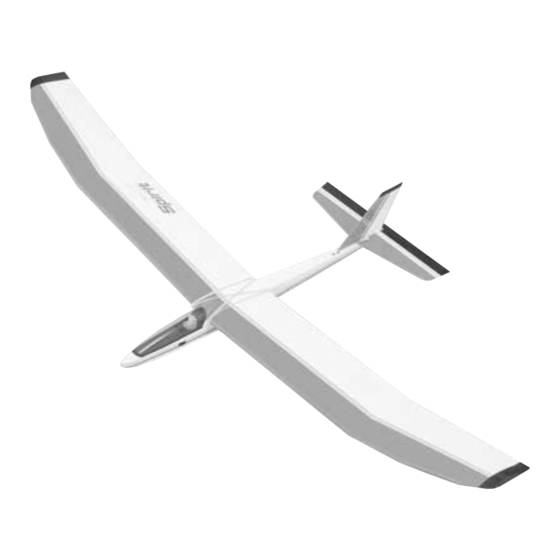GREAT PLANES Spirit Select 사용 설명서 - 페이지 5
{카테고리_이름} GREAT PLANES Spirit Select에 대한 사용 설명서을 온라인으로 검색하거나 PDF를 다운로드하세요. GREAT PLANES Spirit Select 8 페이지. 2-meter sailplane

RADIO SETTINGS
Use the sketch to make sure the control surfaces are moving the
correct directions.
The control throws are as follows:
Elevator
1/2" [13mm] up
1/2" [13mm] down
Rudder
1-1/2" [38mm] left
1-1/2" [38mm] right
Spoilers
90º to the upper surface of the wing
BALANCE THE MODEL
Note: This section is VERY important and must not be
omitted! A model that is not properly balanced will be unstable and
possibly unflyable.
Accurately mark the balance point on the bottom of the wing on
both sides of the fuselage. The balance point is located 3-1/4"
[83mm] back from the leading edge. This is the balance point at
which your model should balance for your first flights. Later, you
may wish to experiment by shifting the balance up to 5/16" [8mm]
forward or back to change the flying characteristics. Moving the C.G.
forward of the spar will add some stability but it will decrease the
overall performance of the sailplane. Moving the balance behind
the spar makes the model more agile with a lighter and snappier
"feel" and improves the sailplane's response to air currents. In any
case, please start at the location we recommend and do not at any
time balance your model outside the recommended range.
With the wing attached to the fuselage, and all parts of the model
installed (ready to fly), lift the model by picking it up with a finger on
each bottom inner spar. If the tail drops when you lift, the model is
"tail heavy" and you must add weight to the nose to balance. If the
nose drops, it is "nose heavy" and you must add weight to the tail
to balance. The model should hang with a slight nose down
attitude. Add BB's or lead to the weight compartment at the front of
the fuselage to correct a tail heavy model. In the unusual
circumstance that you would have a nose heavy model, you can
switch the receiver and battery or even move the receiver behind
the servos. Getting the weight farther back helps correct the "nose
heaviness."
CHECKING FOR WARPS
This is a very important step and should be done occasionally
throughout the flying season. A sailplane's wing is most efficient
when it is not twisted or warped at all. "Washout" (wing trailing
edges twisted up at the tip) helps make a poor wing design fly
better by adding some stability (preventing stalls) at slow speeds
but it cuts down on the wing efficiency at normal speeds. The Spirit
Select's wing is designed to fly well at slow speeds without any
washout, and therefore we recommend you check to make sure
the wings are "flat" using the following procedure:
Set the wing so an inner panel is resting on a flat surface. Any warp
(twist) will show up by causing a corner of the panel to rise off the
work surface.
To remove the warp, gently twist the wing in the opposite direction
while a helper glides an iron or heat gun over the covering on both
the top and the bottom of the panel to re-shrink the covering. Hold
the twist until the covering cools and then recheck for warps. It may
take several tries to get a warp out but it is worth it as you will end
up with a sailplane that flies straight and true and responds to air
currents like a high performance sailplane should.
Follow the same procedure to check all four wing panels and then
go back and double check them. Sometimes you put a warp in one
panel while trying to fix another. You should also look at the tail
surfaces as they too can warp.
PREFLIGHT
Charge the Batteries
Follow the battery charging procedures in your radio instruction
manual. You should charge your transmitter and receiver batteries
the night before you go flying, and at other times as recommended
by the radio manufacturer.
Find a Safe Place to Fly
The best place to fly your R/C model is an AMA (Academy of Model
Aeronautics) chartered club field. Ask your hobby shop dealer if
there is such a club in your area and join. Club fields are set up for
R/C flying which makes your outing safer and more enjoyable. The
AMA can also tell you the name of a club in your area. We
recommend that you join AMA and a local club so you can have a
safe place to fly and also have insurance to cover you in case of a
flying accident. (The AMA address is listed on page 2 of this
instruction book).
If a club and its flying site are not available, you need to find a
large, grassy area at least 6 miles away from any other R/C radio
5
